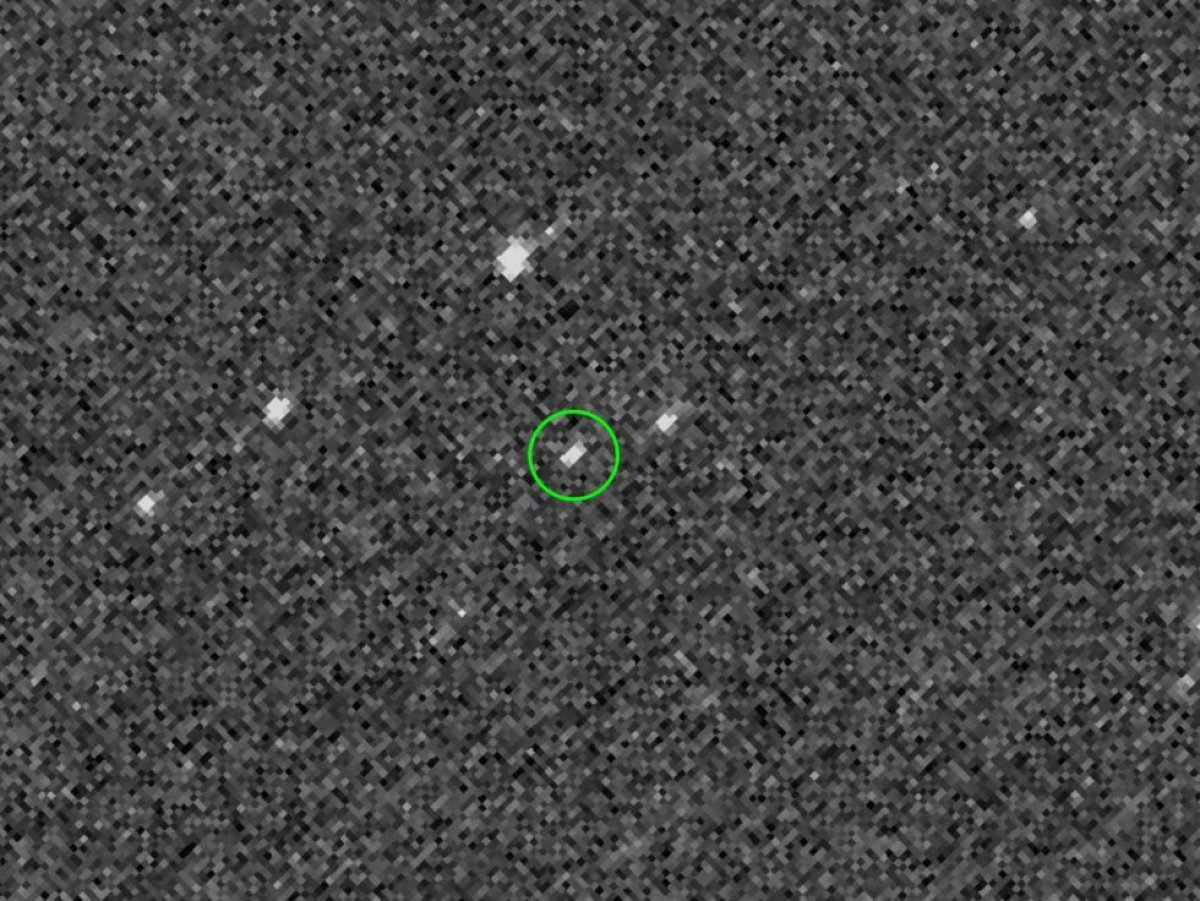NASA has released the first image to be captured by its OSIRIS-REx space probe of the "potentially hazardous" asteroid Bennu. The photo was taken from a distance of around 1.4 million miles on August 17 using the spacecraft's PolyCam instrument—one of three on-board visible light cameras.
The probe launched two years ago from Cape Canaveral, Florida, and is now entering the final approach phase of its mission. Bennu—OSIRIS's target—is a 1,600-foot wide, primitive asteroid which has remained largely unchanged since it formed nearly 4.5 billion years ago. Understanding more about the rocky world is important for several reasons, according to NASA.
Rock and dust on its surface may provide scientists with insights into the early evolution of the Solar System and the origins of life on Earth, for example.
"Bennu is an ancient piece of the early solar system," Jason Dworkin, OSIRIS-REx project scientist, told Newsweek. "Studying it is the study of the origins of the solar system and possibly the life within it."
Researchers are also keen to find out if Bennu contains substances such as water, organic compounds and precious metals. It is hoped that asteroids like it could one day be mined commercially, or their resources harnessed to fuel further exploration of the solar system by robotic and manned spacecraft.
Furthermore, Bennu is considered to be one of the most dangerous of the known Near-Earth Objects due to its relatively high (although still tiny) probability of colliding with the Earth late in the 22nd century. OSIRIS will study the asteroid's physical and chemical properties, which will be critical if a mission is required in the future to deflect or destroy it.
Near Earth Objects (NEOs) are any asteroid or comet whose orbits bring it into the inner solar system within about 121 million miles of the sun, and also within 30 million miles of the Earth's orbit.
If the orbit of a NEO at the time of its discovery is such that there is a (typically small) chance it will collide with Earth and cause significant damage, it is labeled "potentially hazardous," according to the Swinburne Astronomy Online Encyclopedia.
An accurate assessment of Bennu's probability of colliding with the Earth can only be made once scientists have more information on its movement. However, the current best estimates suggest there is a roughly 1 in 2,700 chance of an Earth impact in the 22nd century, (although these odds are likely to change once more data comes in).
OSIRIS-REx is the first NASA mission to visit a Near-Earth asteroid and collect a sample from it.
"Now that OSIRIS-REx is close enough to observe Bennu, the mission team will spend the next few months learning as much as possible about Bennu's size, shape, surface features, and surroundings before the spacecraft arrives at the asteroid," Dante Lauretta, OSIRIS-REx principal investigator at the University of Arizona, Tucson, said in a statement.
"After spending so long planning for this moment, I can't wait to see what Bennu reveals to us."
As OSIRIS-REx approaches Bennu, it will use a variety of scientific instruments to collect information about the asteroid and prepare for its arrival in December this year.
During this approach it will: observe the area around the asteroid to search for dust plumes and natural satellites; study Bennu's light and spectral properties; execute a series of approach maneuvers beginning on October 1, slowing the spacecraft to match Bennu's orbit around the Sun; and use its cameras to reveal the asteroid's shape and surface features.
Once it arrives, OSIRIS will spend a month performing flybys of the asteroid's north pole, equator and south pole at distances ranging between 4.4 and 11.8 miles from the surface. These maneuvers will provide scientists with the first direct measurements of Bennu's mass and give operators a chance to practice navigating near the asteroid.
"Bennu's low gravity provides a unique challenge for the mission," Rich Burns, OSIRIS-REx project manager at NASA's Goddard Space Flight Center in Greenbelt, Maryland, said in the statement. "At roughly 0.3 miles in diameter, Bennu will be the smallest object that any spacecraft has ever orbited."
The probe will conduct extensive investigations of Bennu before identifying a site to collect a sample from in July 2020. This maneuver, referred to as "Touch-And-Go (TAG), will involve a series of delicate braking exercises that will enable OSIRIS to pull up alongside Bennu, which is travelling at average speeds of around 63,000 miles per hour.

Then, a robotic arm will be extended towards to surface, and the momentum of the probe's slow, downward trajectory will push against the asteroid's surface for five seconds—just enough to obtain a sample which will be safely stowed away in a special capsule.
If all goes well, OSIRIS will slowly drift away from Bennu until its main thrusters are turned on again in March 2021 and it begins its long journey back to Earth. Once it approaches home, the capsule will be dropped into Earth's atmosphere where it will fall to the surface, landing in the Utah desert in September 2023 to be recovered.
"The acronym OSIRIS-REx describes the mission," Dworkin said.
"Origins—to study a leftover piece of the early solar system to understand the origins of the planets and possibly of life; Spectral Interpretation—to understand the properties of the asteroid both from the sample and from space and apply what is learned to other asteroids; Resource Identification—to learn how to maneuver around, study, and interact with a small body, which is necessary to enable future prospecting and mining of asteroids; Security—Bennu is a potentially hazardous object and studying how its orbit is changed by sunlight (due to the Yarkovsky Effect) will help understand how to predict and mitigate this and other asteroids from impacting the Earth; Regolith Explorer—to study the fine details of the surface of the asteroid to uncover its properties and history."
Uncommon Knowledge
Newsweek is committed to challenging conventional wisdom and finding connections in the search for common ground.
Newsweek is committed to challenging conventional wisdom and finding connections in the search for common ground.
About the writer
Aristos is a Newsweek science reporter with the London, U.K., bureau. He reports on science and health topics, including; animal, ... Read more
To read how Newsweek uses AI as a newsroom tool, Click here.








